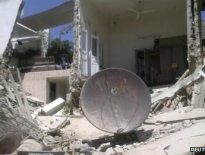BEIJING (AP) — As China’s flood-ravaged capital dealt with the aftermath of the heaviest rain in six decades Monday, including the deaths of 37 people, questions were being raised about whether the city’s push for modernization came at the expense of basic infrastructure such as drainage networks.

Rescuers were still searching buildings that collapsed during Saturday night’s torrential downpour and some roads that were covered in waist-deep water remained closed. The city government said as of Sunday night, 25 people had drowned, six were killed when houses collapsed, one was hit by lightning and five were electrocuted by fallen power lines.
Beijing residents shared photos online of submerged cars stranded on flooded streets, city buses with water up to commuters’ knees and cascades of water rushing down the steps of overpasses.
Nearly 57,000 people had been evacuated from their homes and damages from the storm had reached at least 10 billion yuan ($1.6 billion), according to a report by the Beijing Daily newspaper on the Beijing government website Monday.
Although the worst-hit areas were in rural hilly outskirts of the city, the scale of the disaster was a major embarrassment for Beijing, the showcase capital of China where things like this are not supposed to happen.
The city has seen tens of billions of dollars poured into its modernization, adding iconic venues for the 2008 Olympics, the world’s second-largest airport, new subway lines and dazzling skyscrapers — all while basics like water drainage were apparently neglected.
Many were left wondering how badly prepared other less-prosperous parts of China must be.
“If so much chaos can be triggered in Beijing, the capital of the nation, problems in urban infrastructure of many other places can only be worse,” said a commentary in Monday’s state-run Global Times newspaper. “In terms of drainage technology, China is decades behind developed societies.”
There was similar criticism on the popular microblog service, Sina Weibo.
“This is China’s capital of Beijing. Look what happens when it’s hit by a rainstorm,” wrote Weibo user Wen Hui. “The drainage systems of Rome that were built 2,500 years ago are still in use and you can drive a car through them. Can a dog get through Beijing’s drainage tunnels?”
The criticism mirrors some of that seen after a high-speed train crash that killed 40 people in Wenzhou in southeastern China a year ago Monday. That turned into a public-relations nightmare for the government and led many to question the quality of infrastructure in the country and the government’s transparency on disasters.
Some pointed out that Saturday’s deluge was historic in nature, with the Global Times noting it was the heaviest rainstorm in the capital in 61 years.
“In just in one day, it rained as much as it normally rains in six months in Beijing,” said Zhang Junfeng, a senior engineer from the Ministry of Transport who runs weekend tours of Beijing reservoirs and gives lectures on water conservancy. “No drainage system can withstand rains this big.”
The capital’s skies were clear Monday, with traffic largely back to normal and the city’s main airport operating normally after hundreds of flights were canceled or delayed over the weekend. But hard hit areas were still feeling the effects.
In Qinglonghu, a village about 40 kilometers (25 miles) from downtown Beijing where many migrant workers from surrounding provinces have settled, at least two dozen single-story brick homes were flooded. Local residents said Monday they were terrified to go back into their homes for fear they would collapse. They said they were sleeping outside, had no drinking water or food and had yet to get any assistance from local officials.
At least three people from the village were believed killed, locals said, including a man crushed by a falling power line and a woman and her baby who were washed away.
“We couldn’t save them,” said 50-year-old Wang Lianfeng, a villager who had taken shelter on a roof when she saw the woman and her 8-month-old daughter swept away.
Piles of dirt from a large construction site in Qinglonghu appeared to have formed a dam that kept the downpour from draining into a river, worsening the rain’s damage. Other areas around Qinglonghu appeared minimally affected.
The village is in Fangshan district, the worst hit area of the city, which received 460 millimeters (18.4 inches) of rain on Saturday.
Some Beijing residents complained that the city government was too slow in warning residents about the rain and keeping them updated.
“A lot of the information that got to the public came from Weibo instead of any official government release,” said Dong Liming, a professor at Peking University’s College of Urban and Environmental Sciences. “The government should provide more disaster-related education to the public and precautions for extreme weather.”
Heavy rain also proved deadly elsewhere in the country. Fifteen people were killed and 19 others remained missing in disasters linked to the rainstorms in Hebei province next to Beijing, Xinhua said, citing the provincial civil affairs bureau. Six people were killed by landslides in Sichuan province in the west and four people died in Shanxi province in the north when their truck was swept away by a rain-swollen river. At least eight people died and 17 were missing due to storms in neighboring Shaanxi province, and in Yunnan province in the south, six people were killed and two were missing.





